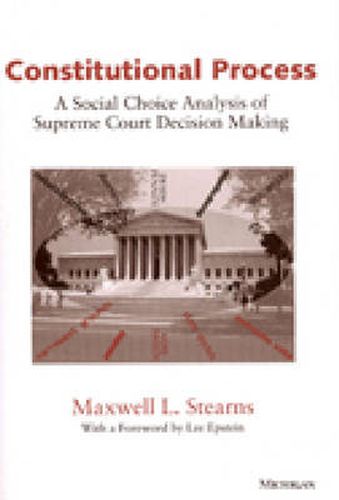Readings Newsletter
Become a Readings Member to make your shopping experience even easier.
Sign in or sign up for free!
You’re not far away from qualifying for FREE standard shipping within Australia
You’ve qualified for FREE standard shipping within Australia
The cart is loading…






This is the first comprehensive analysis of how the collective nature of Supreme Court decision making affects the transformation of the justices’ preferences into constitutional doctrine. Analyzing the Supreme Court from the perspective of social choice theory, Maxwell L. Stearns offers new insights into Supreme Court decision making that have profound implications for understanding the outcomes in a number of cases and the resulting doctrinal development within constitutional law which traditional analyses have proven ill-equipped to explain. The book models several important process-based Supreme Court rules, including outcome voting, the narrowest-grounds rule, stare decisis, and justiciability, with a particular emphasis on standing. These doctrines have each had a significant impact upon the evolution of modern constitutional law, including but not limited to the following areas: affirmative action, school desegregation, racial gerrymandering, obscenity, and abortion. Each model is presented in nontechnical language with several concrete illustrations drawn from recent Supreme Court case law. The book offers a new understanding of two apparently paradoxical situations: first, cases in which there are separate majorities on specific issues in the case that suggest, logically, that there should be a majority for the dissenting result; and second, cases in which discrete minorities–as opposed to the apparent majority–control the identification and resolution of dispositive case issues. In addition, the book sheds new light on why the Court employs stare decisis, even though the doctrine grounds the evolution of legal doctrine on the order in which cases are presented and decided, and on how the modern standing doctrine ameliorates the incentives for interest groups to time the litigation of cases in a way that will exert a disproportionate influence over the direction of constitutional doctrine. This book will appeal to scholars of the Supreme Court or judicial decision-making. It should also be of interest to students of social choice and of law and economics who have not previously considered the Supreme Court or constitutional law as fertile ground for their disciplines. Maxwell L. Stearns is Professor of Law, George Mason University School of Law.
$9.00 standard shipping within Australia
FREE standard shipping within Australia for orders over $100.00
Express & International shipping calculated at checkout
This is the first comprehensive analysis of how the collective nature of Supreme Court decision making affects the transformation of the justices’ preferences into constitutional doctrine. Analyzing the Supreme Court from the perspective of social choice theory, Maxwell L. Stearns offers new insights into Supreme Court decision making that have profound implications for understanding the outcomes in a number of cases and the resulting doctrinal development within constitutional law which traditional analyses have proven ill-equipped to explain. The book models several important process-based Supreme Court rules, including outcome voting, the narrowest-grounds rule, stare decisis, and justiciability, with a particular emphasis on standing. These doctrines have each had a significant impact upon the evolution of modern constitutional law, including but not limited to the following areas: affirmative action, school desegregation, racial gerrymandering, obscenity, and abortion. Each model is presented in nontechnical language with several concrete illustrations drawn from recent Supreme Court case law. The book offers a new understanding of two apparently paradoxical situations: first, cases in which there are separate majorities on specific issues in the case that suggest, logically, that there should be a majority for the dissenting result; and second, cases in which discrete minorities–as opposed to the apparent majority–control the identification and resolution of dispositive case issues. In addition, the book sheds new light on why the Court employs stare decisis, even though the doctrine grounds the evolution of legal doctrine on the order in which cases are presented and decided, and on how the modern standing doctrine ameliorates the incentives for interest groups to time the litigation of cases in a way that will exert a disproportionate influence over the direction of constitutional doctrine. This book will appeal to scholars of the Supreme Court or judicial decision-making. It should also be of interest to students of social choice and of law and economics who have not previously considered the Supreme Court or constitutional law as fertile ground for their disciplines. Maxwell L. Stearns is Professor of Law, George Mason University School of Law.